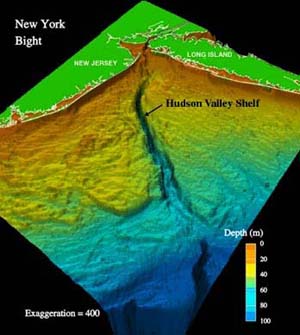New York Bight: Difference between revisions
Port of New York and New Jersey |
link |
||
| Line 5: | Line 5: | ||
[[Image:Hudson_Canyon.jpg|thumb|300px|A colorized depiction of the Hudson Canyon and New York Bight.]] |
[[Image:Hudson_Canyon.jpg|thumb|300px|A colorized depiction of the Hudson Canyon and New York Bight.]] |
||
The '''New York Bight''' is a large [[Headlands and bays|gulf]] on the [[Atlantic Ocean]] along the coast of [[North America]] in the northeastern [[United States]] at the entrance to the [[Port of New York and New Jersey]]. It is formed by the coastal indentation between [[New Jersey]] and [[Long Island]] |
The '''New York Bight''' is a large [[Headlands and bays|gulf]] on the [[Atlantic Ocean]] along the coast of [[North America]] in the northeastern [[United States]] at the entrance to the [[Port of New York and New Jersey]]. It is formed by the coastal indentation between [[New Jersey]] and [[Long Island]] at the entrance to the [[port of New York and New Jersey]]. The [[sea floor]] of the bight consists largely of [[continental shelf]] and includes the [[Hudson Canyon]], an undersea [[Pleistocene]] [[submarine canyon]], probably from the extension of the Hudson River during the [[ice age]]s, when the sea level was lower. The bight includes major shipping channels that access New York Harbor. The coastal climate of the gulf is temperate as the result of direct contact from the [[Gulf Stream]] along the coast of North America. The [[Jersey Shore]] and the coast of Long Island are popular summer recreational spots for the region. |
||
The geography of the bight is such that the coast makes a nearly [[right angle]] bend at the mouth of the Hudson. This feature has long been of major concern to [[meteorologist]]s in the study of [[tropical storm]] patterns along the east coast, and is one of the primary reasons why the [[New York Metropolitan Area]] is considered a high danger zone for storm generated ocean-water surges, despite its northerly latitude. Specifically, in the presence of a hurricane off the coast of New Jersey, the easterly cyclonic winds along the northern edge of the storm could drive a strong surge to the west, laterally along the southern coast of Long Island and straight into [[Lower New York Bay]]. The angle bend of the New Jersey coast would leave little outlet for the surge, leading to widespread flooding throughout [[New York City]], especially along the southern coast of [[Staten Island]] and [[Manhattan]]; [[storm surge]]s of up to {{ft to m|30}} have been reported in a previous hurricane.<ref>http://www.nypress.com/print.cfm?content_id=13427</ref> |
The geography of the bight is such that the coast makes a nearly [[right angle]] bend at the mouth of the Hudson. This feature has long been of major concern to [[meteorologist]]s in the study of [[tropical storm]] patterns along the east coast, and is one of the primary reasons why the [[New York Metropolitan Area]] is considered a high danger zone for storm generated ocean-water surges, despite its northerly latitude. Specifically, in the presence of a hurricane off the coast of New Jersey, the easterly cyclonic winds along the northern edge of the storm could drive a strong surge to the west, laterally along the southern coast of Long Island and straight into [[Lower New York Bay]]. The angle bend of the New Jersey coast would leave little outlet for the surge, leading to widespread flooding throughout [[New York City]], especially along the southern coast of [[Staten Island]] and [[Manhattan]]; [[storm surge]]s of up to {{ft to m|30}} have been reported in a previous hurricane.<ref>http://www.nypress.com/print.cfm?content_id=13427</ref> |
||
Revision as of 21:44, 25 May 2010
It has been suggested that this article be merged with Hudson Canyon. (Discuss) Proposed since May 2010. |
This article needs additional citations for verification. (February 2007) |

The New York Bight is a large gulf on the Atlantic Ocean along the coast of North America in the northeastern United States at the entrance to the Port of New York and New Jersey. It is formed by the coastal indentation between New Jersey and Long Island at the entrance to the port of New York and New Jersey. The sea floor of the bight consists largely of continental shelf and includes the Hudson Canyon, an undersea Pleistocene submarine canyon, probably from the extension of the Hudson River during the ice ages, when the sea level was lower. The bight includes major shipping channels that access New York Harbor. The coastal climate of the gulf is temperate as the result of direct contact from the Gulf Stream along the coast of North America. The Jersey Shore and the coast of Long Island are popular summer recreational spots for the region.
The geography of the bight is such that the coast makes a nearly right angle bend at the mouth of the Hudson. This feature has long been of major concern to meteorologists in the study of tropical storm patterns along the east coast, and is one of the primary reasons why the New York Metropolitan Area is considered a high danger zone for storm generated ocean-water surges, despite its northerly latitude. Specifically, in the presence of a hurricane off the coast of New Jersey, the easterly cyclonic winds along the northern edge of the storm could drive a strong surge to the west, laterally along the southern coast of Long Island and straight into Lower New York Bay. The angle bend of the New Jersey coast would leave little outlet for the surge, leading to widespread flooding throughout New York City, especially along the southern coast of Staten Island and Manhattan; storm surges of up to Template:Ft to m have been reported in a previous hurricane.[1]
References
